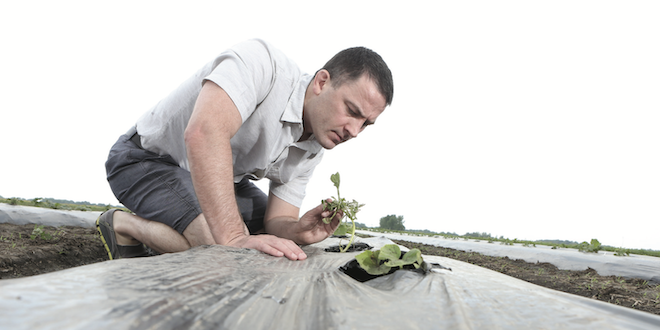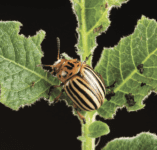

Dec 20, 2021Protein-based biologicals among trends in integrated pest management
Integrated pest management (IPM) is an evergreen topic in specialty crop agriculture, but the industry is always changing as new types of products emerge and techniques are developed.
Here are a few trends in IPM seen in recent months:
1. Protein-based biocontrols.
Belgium-based Biotalys is making efforts at introducing its protein-based Evoca for use in the United States, submitting preliminary paperwork to the EPA in December 2020, and California in April 2021.
A total of 450 trial sites in different regions have been testing Evoca, which is aimed at providing biological control of fungi, especially botrytis, in strawberries, grapes and other high-value crops such as cucurbits, tomatoes and hemp.
Patrice Sellès, the CEO of Biotalys, said in an interview with Fruit Growers News that the product naturally breaks down in the soil.
“It’s not microbial, it’s not a plant extract, it’s not a pheromone – it’s a protein that basically does the same trick as a chemical pesticide or a microbe in terms of eliminating the threat,” he said. “An additional feature is that as a protein, it’s readily biodegradable, which means that it will get back to its constituents, which is completely harmless for soil, for the groundwater, for the environment.” He contrasted that with copper-based fungicides, which can under some conditions accumulate in soils.
Evoca is on track for market introduction in 2022, according to Biotalys. Sellès said the company is able to develop similar protein-based biocontrol products, using a proprietary platform, AGROBODY Foundry.
2. Knowing the modes of action (MOAs) of your products.
“More growers today are implementing IPM strategies to control hard to control pests like whitefly and diamondbacks, which require an IPM strategy prior to season,” said Shan Brooks, Atticus’ director of Florida and specialty markets/ products. “We are also seeing intensity around growers being more aware of the chemical MOAs and combinations of IGRs (insect growth regulators), biologicals and dual IRAC (Insecticide Resistance Action Committee) MOA chemistries.”
Based in Cary, North Carolina, Atticus LLC offers a broad range of branded-generic fungicides, herbicides and insecticides for U.S. row crops and specialty crops. Those products include biological products, which Brooks said are becoming more established.
“We are better understanding the role of biologicals in our cropping practices and implementing them in IPM strategies to complement our synthetic chemistries,” he said. “They are here to stay and necessary for our future.”
Atticus has several new products out, and others in “the pipeline,” Brooks said.
“For the specialty crop markets, Vango ESQ, Acadia ESQ, & Recon Bold SL are our most recent fungicide additions while Daikon is a recent herbicide addition,” he said. “Cyazofamid-based Renaz SC and Carfentrazone-based Antik EC will be launched later this year.”


3. RNA-based biopesticide technology.
A new product from Renaissance BioScience has shown promising results in controlling the Colorado potato beetle.
Independent testing of the biopesticide resulted in a 98.3% mortality rate in larvae and greatly reduced plant damage caused by Colorado potato beetles (CPB), according to a news release from Renaissance.
The proof-of-concept test, conducted by an international agriculture consultancy with expertise in pesticide evaluation, applied Renaissance’s proprietary yeast-based RNA interference technology that is designed to precisely target and turn off a specific CPB gene. The switched-off CPB gene, in turn, resulted in high mortality of the beetles and protected the potato plant. Renaissance said in the release that a benefit of its “novel proprietary RNA production and oral delivery platform technology is that it’s possible to include multiple different gene targets in each cell of the delivery system,” thus reducing the chance for CPB to develop resistance to this innovative biopesticide.
“These are very promising results clearly showing that Renaissance’s environmentally safe technology protected the potato plant from the Colorado potato beetle,” Renaissance BioScience CEO John Husnik said through a press release. “We still have work to do, but these findings confirm the potential for our technology for crop protection. Given that the large-scale, low-cost production of yeast is already readily available from well-established global yeast companies, our focus now is maximizing effectiveness through further laboratory tests and field trials, and organizing appropriate commercial partners for the next phases of product development.”


4. Validation for IPM practice.
Purdue University researchers recently published research into the effects of using integrated pest management to lessen pesticide application.
The study of commercial-scale corn and watermelon fields in the Midwest weighed the benefits and costs of applying pesticides only when the pest levels reached previously established thresholds for damage that would lead to economic losses. These decisions were based on scouting of the fields.
The researchers found the practice led to a 95% reduction in pesticide applications, while maintaining or increasing crop yield for corn and watermelon. The team of researchers from Purdue’s College of Agriculture studied fields at five different locations in Indiana and the Midwest over four years.
“An as-needed approach to pesticide treatment can benefit farmers,” said Ian Kaplan, professor of entomology at Purdue University, who led the project. “With reduced pesticide use, we saw within the first year that wild bees returned to the fields, and our findings showed an average 26% increase in watermelon yield.”
Indiana is one of the major watermelon production states in the U.S., and the pollinator-dependent crop accounts for an average of 7,000 acres of land annually.
— Stephen Kloosterman, associate editor; Photo at top: Ian Kaplan, professor of entomology at Purdue University, examines watermelon plants in the field. Photo: Tom Campbell/Purdue University














